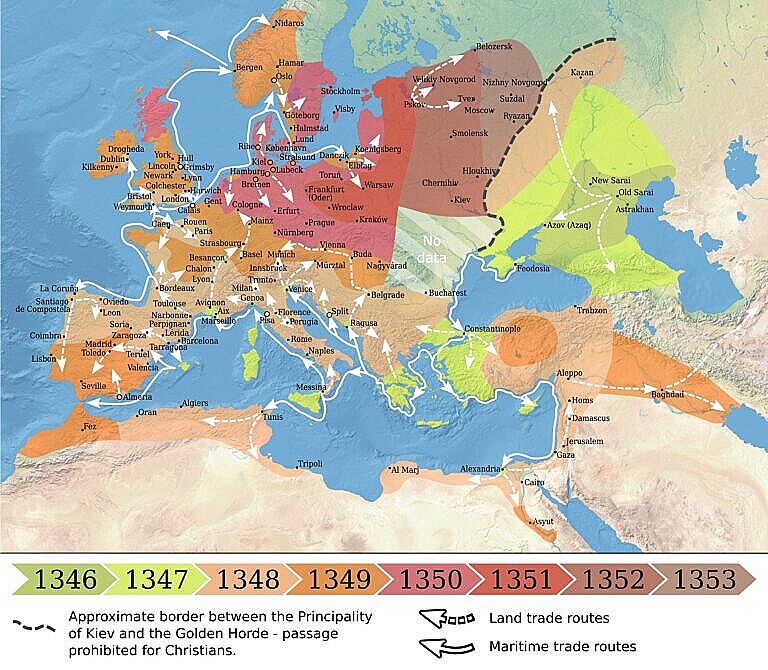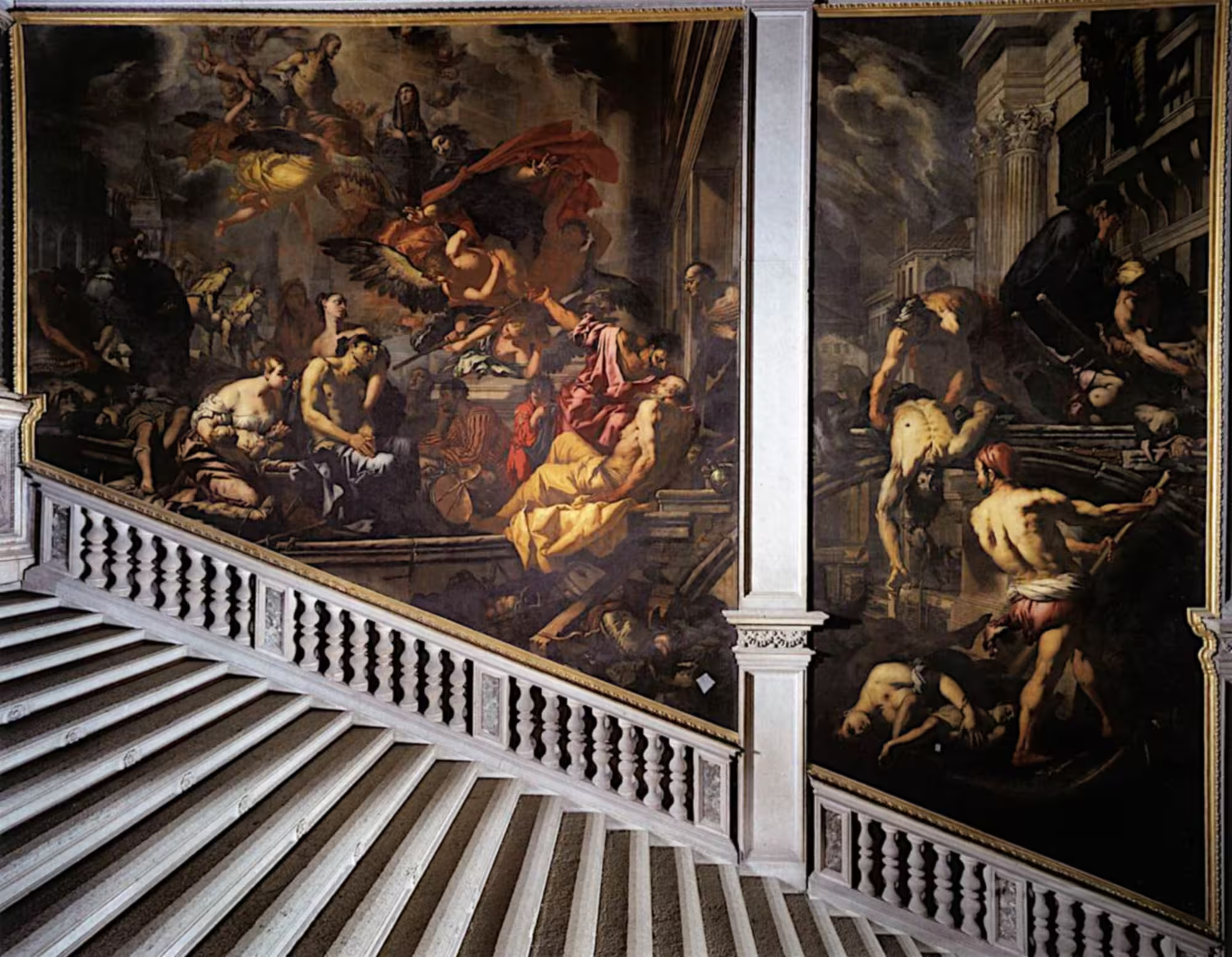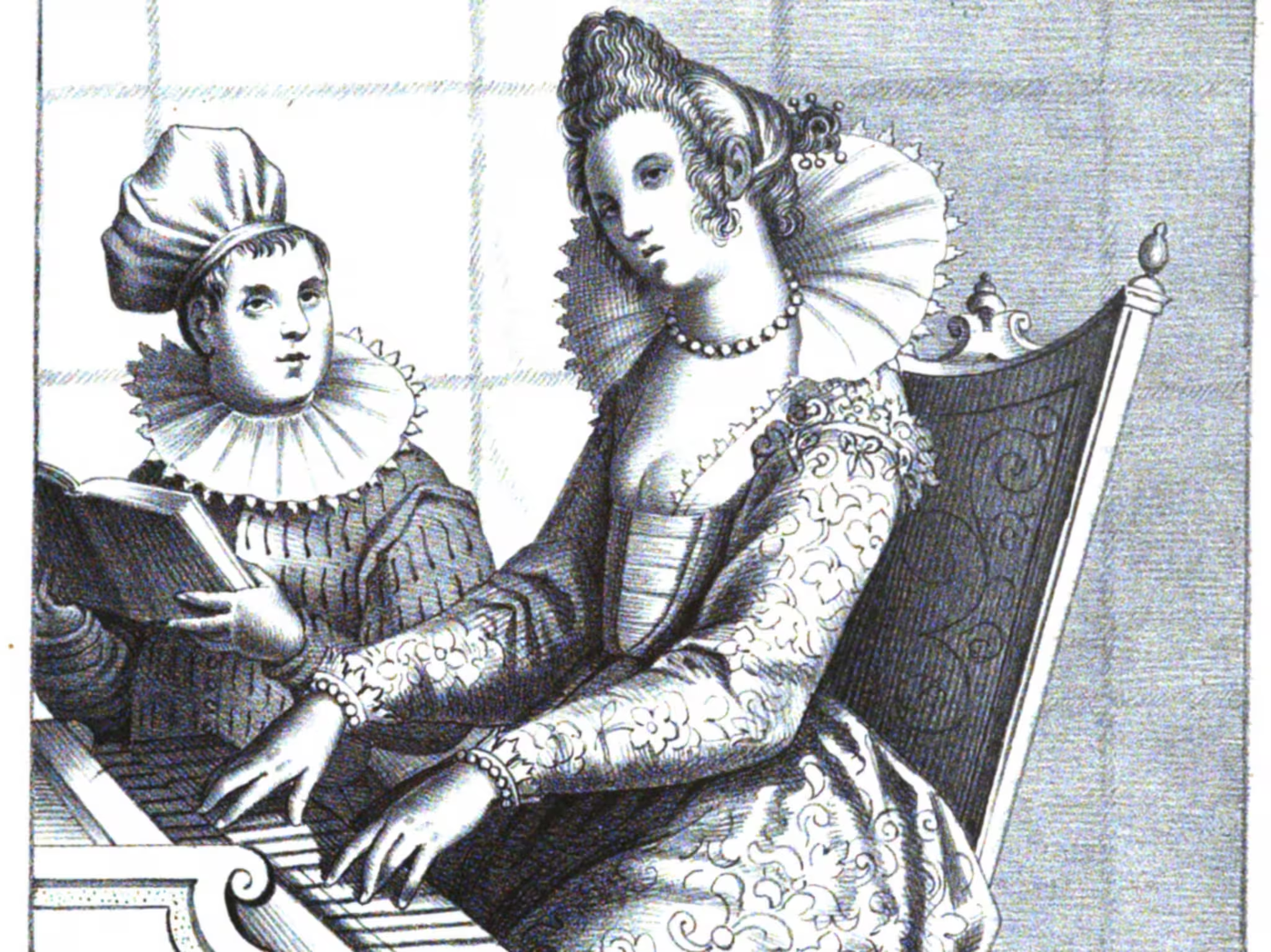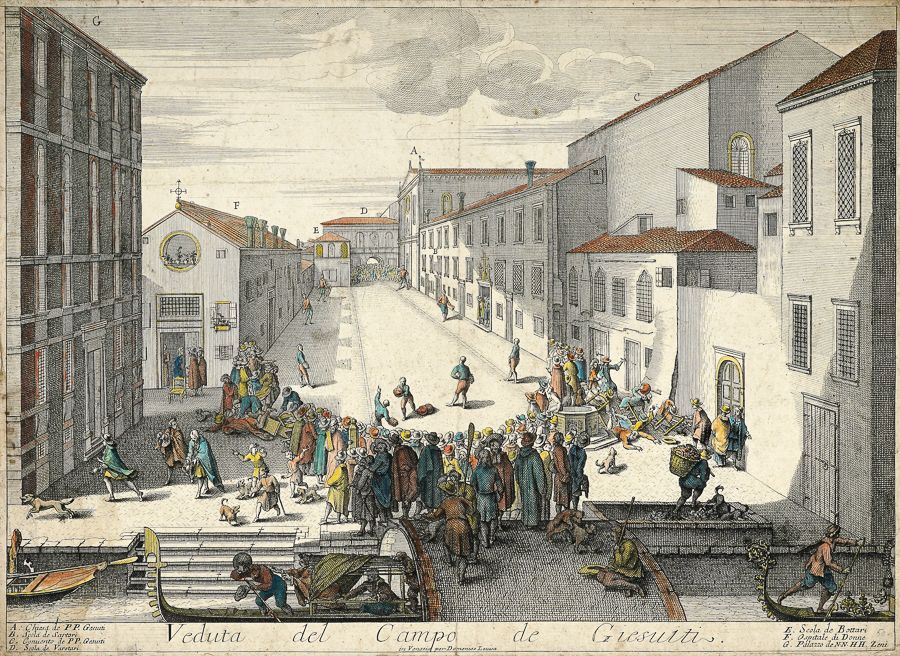Below are a chronology of some of the most important events in Venice related to the black plague, and a list of some notable deaths of the black plague in Venice.
As the chronology shows, the black plague returned again and again for almost a century after its first appearance, until the Venetians set up the lazzaretti.
The first lazzaretto in 1423 and the second in 1468 effectively blocked the plague arriving by sea. In fact, the two later epidemics in Venice, 1575 and 1630, both arrived from the mainland, not from the sea. The lazzaretti worked even if the Venetians had no real understanding of how the plague spread.
The 1300s

- 1346
The black plague appeared somewhere in the Caucasus region. - 1347
The plague reached Constantinople, Greece, and Sicily, travelling along the main trade routes at sea to the major harbour cities. - 1347-48
The plague reached Venice and Genoa for the first time. - 1348
The Consiglio Maggiore elects three Savi (sages) to handle the crisis. This would be repeated at each successive wave of the plague, until the creation of the Magistrato alla Sanità. - 1348-53
The black plague spread throughout all of Europe, killing millions of persons. - 1361
Another wave of the plague - 1371
And another - 1374
And yet another wave of the plague - 1390
And again, a wave of the plague
The 1400s
- 1400
The Senate blocked access for all ships from the Republic of Ragusa to Venetian harbours following an outbreak of the plague there. This was the first attempt at proactive prevention of the plague in Venice. - 1400
Another wave of the plague - 1423
Yet another wave of the plague arrived in Venice. The city nightwatchmen were instructed to report the number of deaths after each night. - 1423
The Senate decided to create an hospice for the sick in the monastery on the island of Santa Maria di Nazareth in the Venetian lagoon. This became the first permanent lazzaretto in history. In the vernacular the island was called Nazaretum, which confused with the name of the neighbouring island of San Lazzaro became Lazaretum, hence Lazzaretto. - 1439
One more wave of the plague - 1456
The Senate elected three Savi (sages) to find a location for a second lazzaretto, so as to separate the sick from those in quarantine. - 1468
The plague returned again. - 1468
The “Vigna Murada” (walled vineyard) in the northern lagoon belonging to the monks of San Giorgio Maggiore became the first permanent quarantine station and got the name Lazzaretto Nuovo. - 1478
A provisional Magistrato alla Sanità was created to administer the lazzaretti and all the safety measures around the prevention of the spread of the plague in Venice. - 1482
The priore (manager) of the Lazzaretto Vecchio was arrested and sentenced to life in prison because he had stolen possession of the dead, and food supplies, which led to the death of several persons on the Lazzaretto Vecchio. While this was an extreme case, examples of fraud and theft in the lazzaretti abounded. - 1485
The Magistrato alla Sanità (basically a Ministry for Public Health) became permanent. It was to manage public health in general, including food safety, and prevention of the plague in particular. The magistracy also administered the lazzaretti. It existed until the end of the Republic of Venice in 1797.
The 1500s
- 1568
The Tezon grando (the large warehouse) was built on the Lazzaretto Nuovo, specifically for the cleansing of the goods from infected ships. It is the second largest extant ancient building in the Venetian lagoon, after the corderie of the Arsenale. - 1573
News arrived in Venice of a major outbreak of bubonic plague in Constantinople. - 1575-77
A major epidemic hit Venice and over 60.000 persons died, which amounted to about one third of the population of the city. - 1575
The Consiglio Maggiore failed to do its tasks during the crisis as too many aristocrats had fled the city for the countryside. - 1576
The Senate vows the construction of a church to redeem the city from the plague. - 1577
The epidemic ended, and the first stone of the Basilica del Redentore laid down. The Festa del Redentore on the third Sunday of July each year commemorates the end of this epidemic. - 1592
The construction of the Basilica del Redentore finished.
The 1600s
- 1630-31
The second and last major epidemic of the black plague in Venice after the introduction of the lazzaretti in the 1400s. - 1631
After the end of the epidemic, the construction of the Basilica della Madonna della Salute (Our Lady of Good Health) at the end of the Grand Canals, started. - 1656
A major plague outbreak in Rome and Naples, but Venice is spared. - 1687
The construction of the Santa Maria della Salute ended.
The 1700s
- mid-1700s
The black plague gradually waned because the grey Norwegian rat supplanted the black Mediterranean rat in the ecosystem. Infected ship became much rarer occurrences. - 1750
The island of Poveglia in the southern lagoon became a quarantine and disinfection station for simpler cases of the black plague on ships entering the lagoon south of Venice. The silting up of the northern harbour entrance close to the Lazzaretto Nuovo and the growth in ship size meant that more and more ships entered the lagoon south of Venice. The island of Poveglia had a good position on this direction. - 1762 onwards
The idea of creating a Lazzaretto Nuovissimo on Poveglia was discussed repeatedly. - c. 1780
The small church of St Bartholemew on the Lazzaretto Nuovo was demolished and the recovered building materials sold. - 1783
A formal project for a Lazzaretto Nuovissimo on Poveglia is presented to the Senate of the Serenissima. - 1792
Only three buildings on the Lazzaretto Nuovo are still in use, but a surveyor deemed them in good enough condition for their purpose. - 1793
A plague infected ship arrived at Poveglia with a load of salted cheeses from Nauplia in Greece. After the cargo was unloaded, the crew fell sick. Before the episode was over, four sailors and eight harbour workers had died. A stone with an inscription was placed on their graves. - 1799
A second ship with the plague on board arrived at Poveglia.
The 1800s
- 1807
An engineer drew up a detailed inventory of the materials constituting the Tezon Grando on the Lazzaretto Nuovo to see if the material could be sold or reused elsewhere profitably. The building was not demolished, however. - 1819
An Austrian ship arrived at Poveglia from Alexandria in Egypt, with a dead Moroccan slave on board, victim of the black plague. Another ship arrived with a sick sailor. - 1821
Two more ships arrived at Poveglia with infectious or sick people on board. - After 1850
The Lazzaretto Nuovissimo was de facto closed, as the buildings on Poveglia were adapted to other functions.
Notable deaths of the black plague in Venice
- 1382
Doge Michele Morosini died just a few months after his election. - 1399
Thomas de Mowbray, 1st Duke of Norfolk, died of the plague while in exile in Venice. - 1438
Four children of the doge Francesco Foscari died of the plague. - 1479
Dogaressa Taddea Michiel, wife of doge Giovanni Mocenigo died of the plague. - 1485
The Doge Giovanni Mocenigo died of the plague, which led to some odd changes in the state funeral of a deceased doge. - 1510
Giorgio da Castelfranco, painter, best known as Giorgione, died of the plague. He was probably buried in an unmarked grave on the Lazzaretto Nuovo, but the details are unknown. - 1576
Tiziano Vecellio, painter, better known as Titian, and his son Orazio both died of the plague. Titian in his home in Venice, Orazio in the Lazzaretto Nuovo. - 1576
Wife and daughter of Francesco Sansovino died in the epidemic. Sansovino himself quarantined at the Lazzaretto Nuovo.
Related articles
- The Black Plague
- The Venetian Lazzaretti
- A Chronology of the Lazzaretto Nuovo
- A Chronology of Lazzaretto Vecchio





Leave a Reply